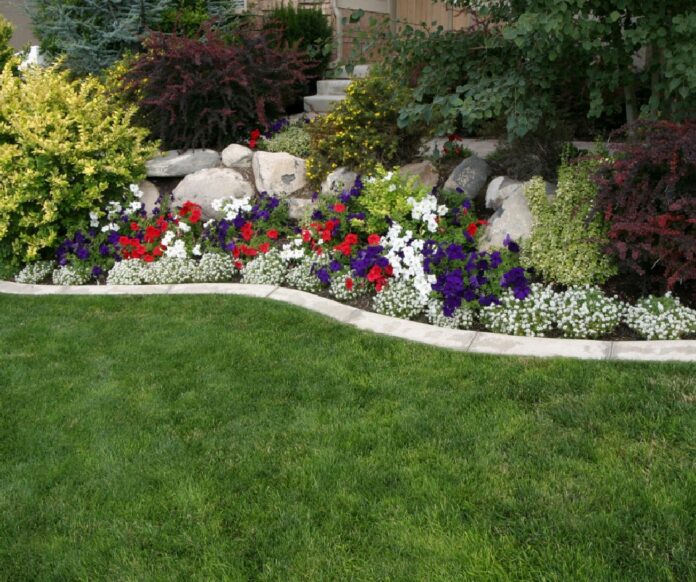You might be looking for ways to make your yard more eco-friendly, right? Sustainable landscaping is a great way to create a beautiful yard while also reducing your environmental impact. By incorporating environmentally-friendly practices into your landscaping, you can help conserve resources, protect wildlife, and reduce pollution.

In this post, we’ll share five tips for creating an eco-friendly yard that’s both beautiful and sustainable. Learn more about sustainable landscaping and how you can make a difference in your backyard.
5 Tips For Creating An Eco-Friendly Yard
Tip #1: Use Native Plants
Using native plants in your landscaping is an excellent way to support local ecosystems and reduce your water usage. Native plants are adapted to the local climate and soil conditions, which means they require less water and fertilizer than non-native plants. They also provide important habitats for local wildlife, including birds and insects.
Tip #2: Compost Yard Waste
Composting is an easy and effective way to reduce your yard waste and improve your soil quality. By composting leaves, grass clippings, and other organic matter, you can create a nutrient-rich soil amendment that will help your plants thrive. Composting also reduces the amount of waste that ends up in landfills, where it produces methane, a potent greenhouse gas.
Tip #3: Choose Sustainable Materials
When choosing materials for your landscaping, opt for sustainable options whenever possible. For example, use permeable pavers instead of concrete to allow rainwater to soak into the ground, or choose recycled materials for your outdoor furniture. You can also look for products that are certified by organizations like the Forest Stewardship Council (FSC) or the Sustainable Forestry Initiative (SFI), which ensure that the wood used comes from responsibly managed forests.
Tip #4: Install Rain Barrels
Installing a rain barrel is a simple and effective way to conserve water and reduce your water bill. A rain barrel collects rainwater from your roof, which you can then use to water your plants and garden. This not only reduces your water usage but also helps to prevent stormwater runoff, which can contribute to water pollution.
Tip #5: Plant Trees
Planting trees is an excellent way to reduce your carbon footprint and improve air quality. Trees absorb carbon dioxide from the atmosphere and release oxygen, which helps to mitigate the effects of climate change. They also provide shade, which can reduce your cooling costs in the summer. When planting trees, choose species that are appropriate for your climate and soil conditions.
Check Also: Why Pruning Your Trees Is Important
Frequently Asked Questions About Having an Eco-Friendly Yard
What is an eco-friendly garden?
An eco-friendly garden is a type of garden that promotes sustainability by using environmentally friendly practices and techniques to grow plants, herbs, vegetables, and fruits. It focuses on reducing the negative impact of gardening on the environment while maintaining a healthy garden ecosystem.
What are the benefits of having an eco-friendly garden?
The benefits of having an eco-friendly garden include reducing your carbon footprint, conserving water, improving soil health, attracting beneficial wildlife, and creating a natural and healthy environment.
What are some eco-friendly gardening practices?
Some eco-friendly gardening practices include composting, using natural fertilizers and pesticides, conserving water through drip irrigation or rainwater harvesting, planting native plants, using mulch to retain moisture, and reducing lawn areas.
What are the best plants for an eco-friendly garden?
The best plants for an eco-friendly garden are native plants that are adapted to the local climate and soil conditions. These plants require less water, fertilizer, and pesticides than non-native plants and provide habitat and food for local wildlife.
How can I reduce waste in my eco-friendly garden?
You can reduce waste in your eco-friendly garden by composting kitchen scraps and yard waste, using recycled materials for garden structures, avoiding disposable products such as plastic pots and trays, and reusing or repurposing materials whenever possible.
How can I attract beneficial wildlife to my eco-friendly garden?
You can attract beneficial wildlife to your eco-friendly garden by providing food, water, and shelter. This can be achieved by planting native plants, creating a water source such as a birdbath or pond, and providing nesting sites such as birdhouses or bee hotels.
How can I maintain an eco-friendly garden without using harmful chemicals?
You can maintain an eco-friendly garden without using harmful chemicals by using natural pest control methods such as companion planting, handpicking pests, using insecticidal soaps or oils, and releasing beneficial insects such as ladybugs or praying mantises.
In conclusion, sustainable landscaping is a great way to create a beautiful yard while also reducing your environmental impact. By following these five tips, you can create an eco-friendly yard that’s both beautiful and sustainable. Remember to visit Project Landscape to learn more about sustainable landscaping and how you can make a difference in your backyard.






















